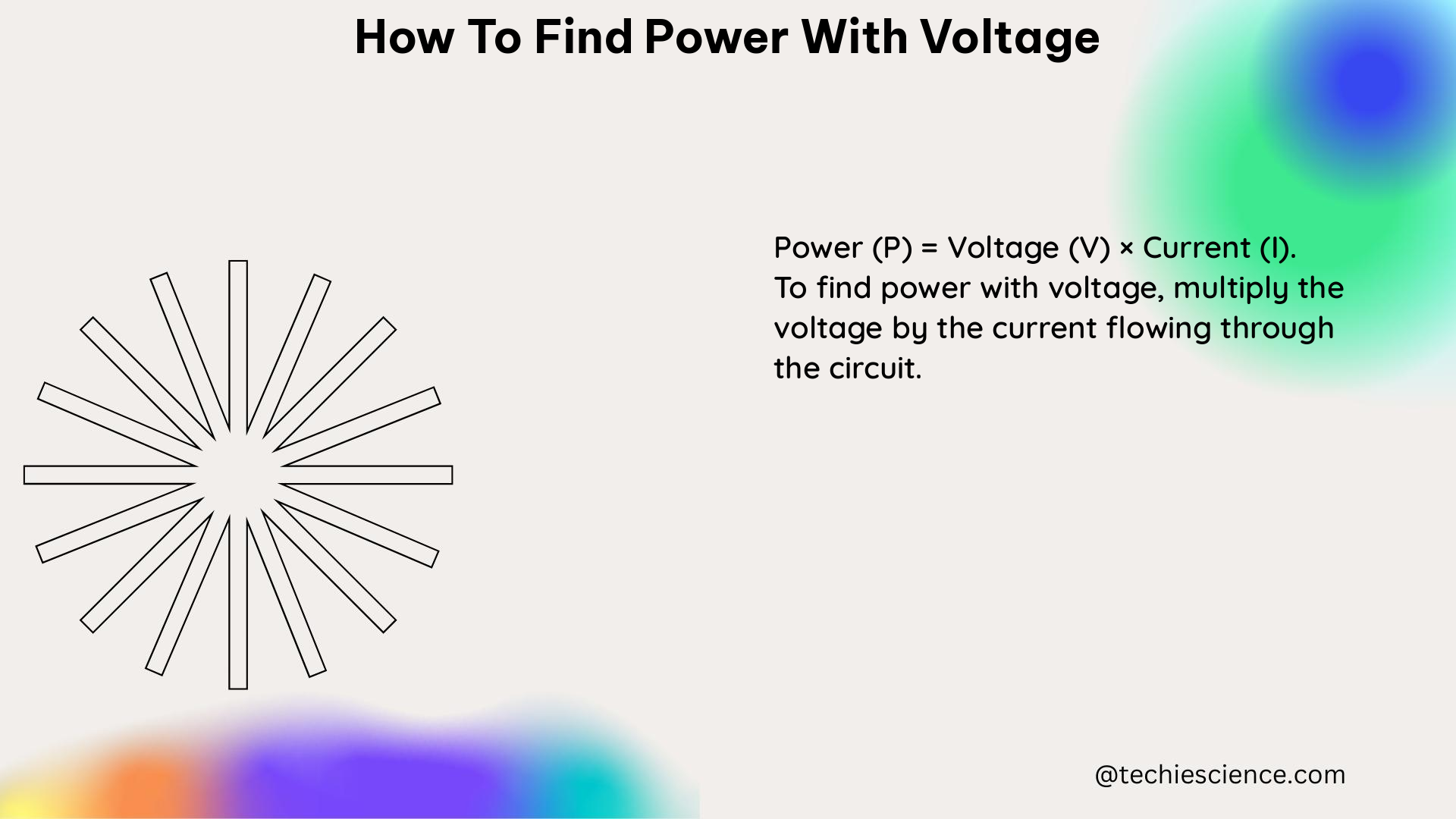As a physics student, understanding how to calculate power from voltage is a fundamental skill. This comprehensive guide will provide you with the necessary theoretical knowledge, formulas, examples, and practical applications to master the art of finding power with voltage.
Understanding the Relationship between Power, Voltage, and Resistance
The relationship between power (P), voltage (V), and resistance (R) is governed by the formula:
P = V^2 / R
This formula is derived from Joule’s Law, which states that the heat produced in a resistive element is proportional to the square of the current and the resistance.
Let’s consider an example:
Suppose you have a circuit with a voltage of 10 volts and a resistance of 5 ohms. To calculate the power, we can plug the values into the formula:
P = V^2 / R
P = 10^2 / 5
P = 100 / 5
P = 20 watts
In this case, the power dissipated in the circuit is 20 watts.
Measuring Power with Voltage and Current

While the formula P = V^2 / R is useful when you know the voltage and resistance, it’s important to note that this formula assumes a constant voltage and resistance. In real-world scenarios, these values may vary over time, which can affect the accuracy of the power calculation.
To measure the power in a circuit more accurately, you can use a power meter or an oscilloscope to measure the voltage and current simultaneously. The power can then be calculated using the formula:
P = IV
where I is the current.
When measuring the power in a circuit, it is crucial to ensure that the voltage and current are measured simultaneously. This is because there can be a phase difference between the two signals, which can affect the accuracy of the power calculation. If the samples are not taken simultaneously, the calculated power may not be accurate.
Practical Applications and Considerations
The ability to calculate power from voltage is essential in various fields, such as electrical engineering, electronics, and renewable energy systems. Here are some practical applications and considerations:
-
Power Consumption in Electrical Devices: Knowing the power consumption of electrical devices, such as appliances, electronics, and motors, is crucial for energy management, load planning, and efficiency optimization.
-
Renewable Energy Systems: In solar photovoltaic systems, wind turbines, and other renewable energy technologies, the ability to calculate power from voltage is essential for sizing the system components, estimating energy production, and optimizing the system’s performance.
-
Power Transmission and Distribution: In the context of power grids and transmission lines, the power calculation based on voltage is crucial for load balancing, voltage regulation, and efficient energy distribution.
-
Battery and Energy Storage Systems: Calculating the power of battery-powered devices and energy storage systems is essential for determining their capacity, runtime, and efficiency.
-
Electrical Circuit Design: When designing electrical circuits, the power calculation based on voltage and resistance is crucial for selecting the appropriate components, ensuring proper power delivery, and preventing overloads or damage.
Advanced Considerations and Techniques
For more advanced applications, there are additional techniques and considerations to take into account when finding power with voltage:
-
Alternating Current (AC) Circuits: In AC circuits, the power calculation must consider the phase difference between voltage and current, which can be done using the formula
P = VI cos(θ), whereθis the phase angle between voltage and current. -
Complex Impedance: When dealing with complex impedances, the power calculation must consider the reactive components, which can be done using the formula
P = VI cos(φ), whereφis the phase angle between voltage and current. -
Power Factor Correction: In some applications, such as industrial or commercial power systems, power factor correction techniques may be employed to improve the efficiency of power transmission and utilization.
-
Harmonic Analysis: In the presence of harmonics in the voltage or current waveforms, advanced techniques like Fourier analysis may be required to accurately calculate the power.
-
Transient and Dynamic Conditions: When dealing with rapidly changing or transient conditions, the power calculation may require the use of differential equations and dynamic modeling techniques.
By understanding these advanced concepts and techniques, you can expand your knowledge and apply it to more complex power-related problems in your physics studies and future career.
Conclusion
Mastering the art of finding power with voltage is a crucial skill for physics students. This comprehensive guide has provided you with the necessary theoretical knowledge, formulas, examples, and practical applications to help you become proficient in this area. Remember to always consider the specific conditions and factors that may affect the accuracy of your power calculations, and be prepared to adapt your approach as needed.
References
- Calculating power and energy based on frequency and amplitude. (n.d.). Physics Forums. https://www.physicsforums.com/threads/calculating-power-and-energy-based-on-frequency-and-amplitude-pascal.760536/
- How do we compute power from current and voltage samples? Can we quantify its accuracy? (n.d.). Electronics Stack Exchange. https://electronics.stackexchange.com/questions/418614/how-do-we-compute-power-from-current-and-voltage-samples-can-we-quantify-its-ac
- Calculating Electric Power | Ohm’s Law | Electronics Textbook. (n.d.). All About Circuits. https://www.allaboutcircuits.com/textbook/direct-current/chpt-2/calculating-electric-power/
- Calculate Current (Amps) with Ohm’s Law and the Power Formula. (n.d.). Elliott Electric Supply. https://www.elliottelectric.com/StaticPages/ElectricalReferences/Calculations/Ohms_Law_Calculating.aspx
- HANDBOOK OF ELECTRIC POWER CALCULATIONS. (n.d.). https://dl.icdst.org/pdfs/files/4611fc8a38c46c066eb2b29dd25d9bc1.pdf

The lambdageeks.com Core SME Team is a group of experienced subject matter experts from diverse scientific and technical fields including Physics, Chemistry, Technology,Electronics & Electrical Engineering, Automotive, Mechanical Engineering. Our team collaborates to create high-quality, well-researched articles on a wide range of science and technology topics for the lambdageeks.com website.
All Our Senior SME are having more than 7 Years of experience in the respective fields . They are either Working Industry Professionals or assocaited With different Universities. Refer Our Authors Page to get to know About our Core SMEs.